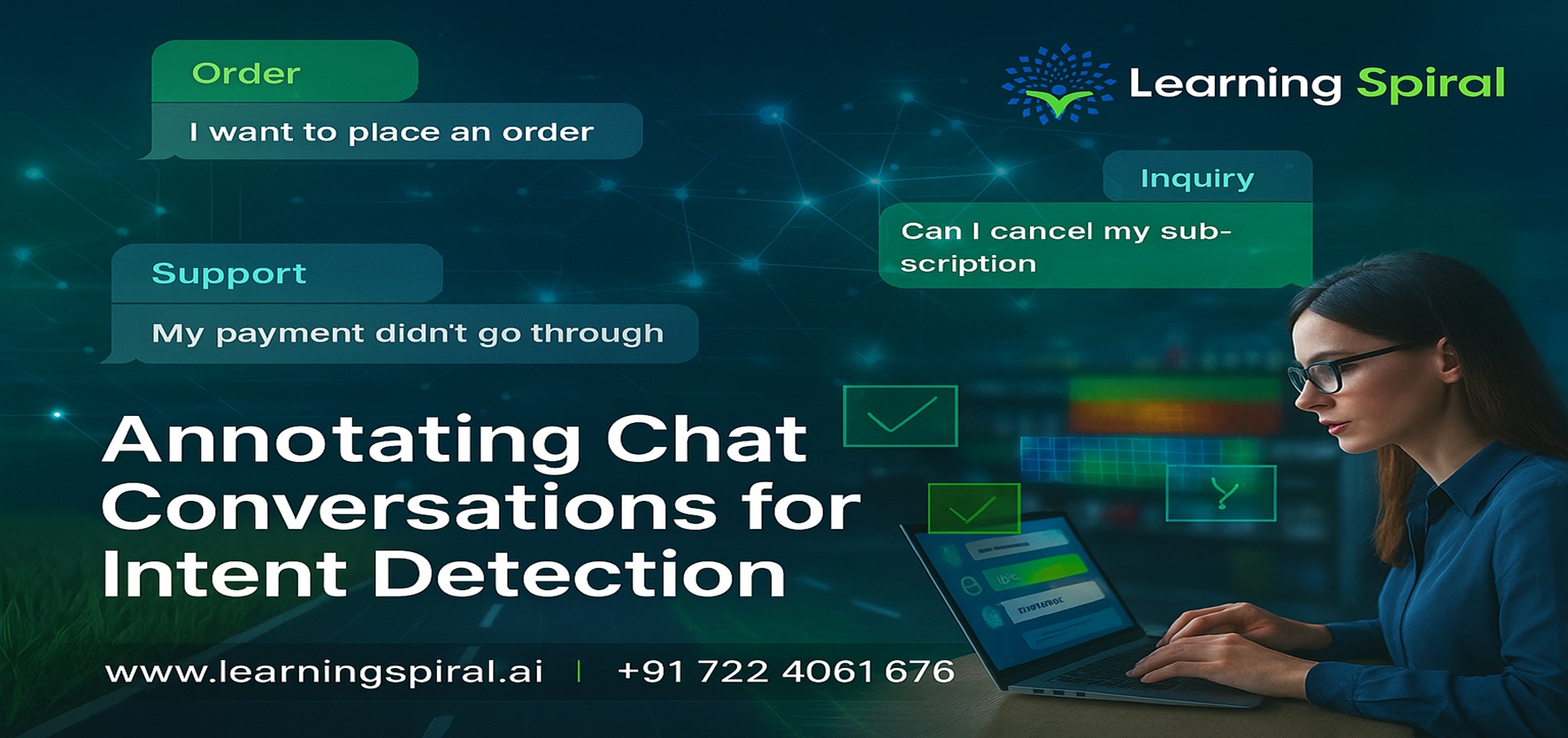
Conversational AI is rapidly transforming how businesses, institutions, and digital platforms interact with users. Whether it is a virtual teaching assistant responding to student queries, a customer support chatbot helping users troubleshoot, or an automated appointment scheduler, the effectiveness of these systems relies on their ability to correctly understand intent.
Intent detection refers to identifying the purpose or goal behind a user’s message. For example, “How can I reset my password?” expresses the intent to recover account access, while “Cancel my last transaction” expresses a service cancellation intent. However, real human communication is complex — users may type incomplete sentences, mix languages, use slang, or imply meaning indirectly. That’s why manual chat conversation annotation is essential for training reliable NLP models.
What Is Intent Detection?
Intent detection is a natural language processing (NLP) task that classifies text messages into predefined categories. These intent labels allow AI systems to trigger the correct response or workflow.
Common intent categories include:
-
Request for help
-
Complaint / dissatisfaction
-
Information inquiry
-
Purchase intent
-
Cancel / modify request
-
General conversation / small talk
-
Feedback or suggestions
For universities, research groups, EdTech platforms, customer support systems, and enterprise chatbots, accurately identifying user intent leads to smoother interactions, higher satisfaction, and better automation efficiency.
Why Annotating Chat Conversations Is Essential
Raw chat data alone cannot train an accurate model. Chat messages must be labeled systematically so that the model learns how similar patterns map to specific intents.
High-quality annotation helps models:
-
Understand varied linguistic patterns
-
Distinguish between similar-sounding intents
-
Recognize context and speaker roles
-
Reduce confusion and misclassification errors
-
Adapt to domain-specific terminology
Without proper annotation, the model may respond incorrectly, misunderstand user sentiments, or fail in critical workflows.
Types of Chat Annotation for Intent Detection
1. Intent Labeling
Each user message is tagged with an intent category based on its purpose.
Example:
| Chat Message | Intent Label |
|---|---|
| “I want to change my exam center” | Change Request |
| “My login isn’t working” | Technical Support |
| “What are the course registration dates?” | Information Inquiry |
2. Entity Recognition
Entities are key pieces of information within the message. Identifying them helps models extract actionable data.
Example entities:
-
Names
-
Dates
-
Course codes
-
Transaction IDs
-
Locations
Example:
“Reschedule my appointment to Monday at 2 PM.”
Entities: Day: Monday, Time: 2 PM
3. Sentiment & Tone Tagging
Human conversations are emotional. Recognizing tone strengthens model responsiveness.
Sentiment categories:
-
Positive
-
Neutral
-
Negative
-
Urgent
-
Frustrated
This helps AI prioritize critical tasks and escalate when necessary.
4. Conversation Sequencing
Some intents only become clear through context across multiple messages. Annotators track conversational flow to label intent transitions accurately.
Annotation Challenges in Real-World Chat Data
Chat conversations are rarely clean. They may include:
-
Spelling errors → “plz snd detls”
-
Code-mixed language → “Sir, exam kab start hoga?”
-
Emoji-based meaning → “👍” = approval or completion
-
Indirect requests → “I guess my account is stuck again…”
Human annotators are essential because they understand cultural cues, tone, emotion, and implied meaning — areas where automated systems still struggle.
The Role of High-Quality AI Training Data
Machine learning models learn patterns based on the examples they see. If training data is ambiguous, inconsistent, or inaccurately labeled, model performance degrades significantly.
High-quality training data ensures:
-
Higher intent classification accuracy
-
Fewer model errors in production
-
Better user experience in automated systems
-
Improved scalability of conversational workflows
This is why annotation is not just a step — it’s the foundation of reliable NLP systems.
Industries That Benefit From Intent Detection
-
EdTech and Universities: Student support systems, inquiry chatbots, LMS helpdesks
-
Banking and FinTech: Fraud alerts, transaction support, customer queries
-
Healthcare: Patient appointment scheduling, symptom description bots
-
E-commerce: Order tracking, returns/cancellation automation
-
Customer Support and CRM Platforms
Any industry using conversational interfaces relies on precise intent detection.
How Learning Spiral AI Supports Intent Annotation Projects
Learning Spiral AI provides scalable, high-accuracy chat conversation annotation services tailored for:
-
Academic research labs
-
AI product teams
-
Conversational AI solution providers
-
Enterprises adopting smart customer support tools
Our annotation workflow ensures:
-
Consistent intent taxonomies
-
Domain-specific annotation guidelines
-
Trained linguistic annotators
-
Multi-level quality control review
-
Secure data handling and confidentiality
We work closely with clients to define intent structures that align with real-world use cases.
Annotating chat conversations for intent detection is a critical foundation for building effective conversational AI systems. High-quality labeled data enables models to understand user goals, respond intelligently, and automate communication processes efficiently. Whether developing academic NLP models or enterprise chatbots, reliable annotation ensures better outcomes.
📩 Ready to improve your intent detection models?
Contact Learning Spiral AI to discuss annotation workflows, pricing, or pilot dataset support.

